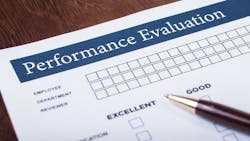This is part one of a two-part series on the evolution of the employee evaluation process.
I learned something interesting at a recent NationaLease meeting: Performance appraisals can be traced back to the U.S. military’s “merit rating” system, created during World War I to identify poor performers for discharge or transfer. When first implemented, “improving performance was an afterthought,” according to Jeanne Stewart, founder and president of HR On The Move.
Fast forward to the early 2000s, and organizations were using performance appraisals to hold employees accountable and to allocate rewards in the form of pay raises and bonuses. In the middle of that decade, many executives began to question whether it was useful to compare employees to each other and rate them on a scale.
Most employees hate the appraisal process and managers hate doing these annual reviews—neither side seeing value in them. In 2011, Adobe began a process of constant assessments with more frequent check-ins replacing annual reviews. Other companies followed suit.
If you have not already moved to replace your annual performance reviews, Stewart offers three reasons why you should consider doing so:
The return of people development: Competitive pressure has made it essential that companies continue to develop their employees’ skills. “This approach requires rich feedback from supervisors — a need that’s better met by frequent, informal check-ins than by annual reviews,” Stewart said. Additionally, given the current people shortage, employers are trying to eliminate things that lead to employee dissatisfaction; this includes annual reviews.
The need for agility: Rapid innovation has become a competitive advantage and it no longer makes sense to hold people accountable for past or current practices. It also no longer makes sense to plot employees’ goals and tasks out a year in advance, she explained. The move is to more frequent interaction with employees that focus on two questions: what the employee should keep doing and what needs to be changed.
The centrality of teamwork: Shifting the focus to individual accountability rather than forced rankings helps with developing teamwork. Teamwork and collaboration have become increasingly important for business success.
When moving away from annual performance reviews, one question that arises centers around how often these more frequent check-ins should occur. There is no pat answer for that. “The frequency of review must fit business cycles,” Stewart said. “If business growth is evaluated on a quarterly basis, it makes sense to also evaluate performance on the same cycle.” In addition, the frequency of employee reviews can vary by department.
The COVID-19 pandemic has forced companies to evaluate many of their business practices. Now might be a good time to review how you evaluate employees considering changing business dynamics that now place more value on developing talent, agility, and teamwork.
Stay tuned for part two of “New and improved employee evaluations,” which will focus on what should be included in these more frequent employee evaluations.
Jane Clark focuses on managing the member services operation at NationaLease as vice president of member services. She works to strengthen member relationships, reduce member costs, and improve collaboration within the NationaLease supporting groups.
About the Author
Jane Clark
Senior VP of Operations
Jane Clark is the senior vice president of operations for NationaLease. Prior to joining NationaLease, Jane served as the area vice president for Randstad, one of the nation’s largest recruitment agencies, and before that, she served in management posts with QPS Companies, Pro Staff, and Manpower, Inc.
